Increasing Lyophilization Productivity, Flexibility, and Reliability Using Liquid Nitrogen Refrigeration–Part 2
The second of a two part article.
ABSTRACT
In part 1 of this article, published in the November 2007 issue of BioPharm International, the lyophilization process, related equipment, and refrigeration requirements were discussed. This part 2 introduces key design considerations related to cryogenic refrigeration systems and provides guidance on relative cost factors for using cryogenic versus mechanical refrigeration in lyophilization operations. The article also discusses reliability and maintenance requirements; flexibility in terms of operating temperature range, cooling rate capability, and precision of temperature control; cost of ownership; footprint; and environmental impact.
Flexible, precise, and reliable cooling of the shelves and condenser in a lyophilizer is critical to effectively freeze-dry and protect a broad range of sensitive, high value pharmaceutical products. Conventional cooling methods, as introduced in part 1 of this article, include using either mechanical or cryogenic nitrogen-based refrigeration. Part 2 begins with an overview of the fundamental thermodynamic characteristics of cryogenic nitrogen and the factors influencing the maximum amount of refrigeration available from cryogenic systems. An optimal refrigeration design provides flexible, robust cooling at reduced cost of ownership versus mechanical alternatives.
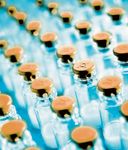
We will now review the fundamental thermodynamic characteristics of cryogenic nitrogen, and the factors influencing the maximum amount of refrigeration available from the cryogenic fluid.
FUNDAMENTALS OF CRYOGENIC REFRIGERATION
Liquid and Gaseous Nitrogen
Pressure and temperature are two key intensive thermodynamic variables that determine the state of any saturated fluid and thus the refrigeration available from it. The saturation pressure of liquid nitrogen as a function of temperature is shown in Figure 1.
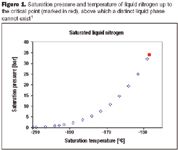
Figure 1.
Maximum Refrigeration from Liquid Nitrogen
Saturated liquid nitrogen stores refrigeration in the form of its latent heat of vaporization, i.e., the energy associated with the liquid changing state to gas without a temperature change. Boiling the liquid nitrogen (LN2) to gaseous nitrogen (GN2) provides the refrigeration in a cryogenic heat exchanger. Figure 2 illustrates the available latent heat as a function of operating pressure and temperature. The lower the pressure and temperature, the more refrigeration is available for recovery.

Figure 2.
Maximum Refrigeration from Gaseous Nitrogen
Sensible heat is the energy associated with a change in the temperature of a substance. Depending on the cryogenic system design, the sensible heat from warming the gas may also be recovered in the same or another heat exchanger. The two key factors that determine the maximum amount of refrigeration recoverable per unit mass of cryogen are the heat capacity and the temperature rise of the fluid.
Maximum Refrigeration Recoverable from Liquid and Gaseous Nitrogen
We can calculate the total recoverable refrigeration from cryogenic nitrogen by adding the two key components, i.e., the latent and sensible heat. Figure 3 shows an example of total available refrigeration as a function of gas exhaust temperature for near-atmospheric-pressure operation. The latent heat from vaporizing the liquid and the sensible heat from warming the gas each account for approximately 50% of the available refrigeration capacity under typical operating conditions. At higher pressures, the latent heat of vaporization decreases, as shown in Figure 2, thus reducing the total available refrigeration.
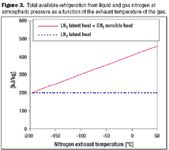
Figure 3.
COMPARISON OF VARIOUS CRYOGENIC REFRIGERATION SYSTEMS
This section describes cryogenic heat exchange technologies in terms of freezing characteristics, efficiency of refrigeration utilization, and operating parameters as related to system design. Additional critical design considerations are also outlined.
Refrigeration Utilization Efficiency of Cryogenic Systems
At a given operating temperature and pressure, the fundamental thermophysical properties of cryogenic nitrogen (discussed earlier) make a certain amount of refrigeration available from the fluid. If a 100% efficient cryogenic refrigeration system existed, thermodynamics would still limit the amount of refrigeration available. The design and implementation of the cryogenic cooling system determines what percentage of the available refrigeration is actually recovered by first vaporizing the LN2, and subsequently warming the GN2. The majority of current designs recover most of the latent heat of vaporization. However, designs vary in their capability of recovering the sensible heat by warming the gas. The closer the approach temperature of the gas exhaust is to the heat transfer fluid (HTF) outlet temperature, the higher the efficiency of the cryogenic heat exchanger. We have demonstrated a design that recovers 95–98% of the available refrigeration in a single cryogenic heat exchanger. These efficiencies have been achieved in commercial systems with refrigeration capacities up to 150 kW and operating temperatures as low as –80 °C.
Freezing Characteristics
When cryogens are used to cool anything, freezing the entire heat exchange system is a serious concern. LN2 boils at –195.8 °C at atmospheric pressure. As discussed earlier, almost all HTFs used in lyophilization freeze at well above this temperature. Freezing of the HTF has limited the widespread application of cryogenic heat exchangers. Some cryogenic heat exchanger designs freeze after only a few hours of operation.2 For longer cooling cycles, several such units are needed to enable parallel defrosting of the frozen heat exchangers and to compensate for refrigeration capacity losses due to the insulating properties of ice.
Recent years have seen the development of nonfreezing cryogenic heat exchanger designs that eliminate the need to switch between frozen and defrosted units. Such nonfreezing designs enable cooling over the long cycles used by lyophilization. They include both a single heat-exchanger design3 and multi-heat-exchanger systems, which use high-pressure fluid ejectors4 or plate-and-frame designs.5 These designs avoid any heat transfer surfaces where HTF is on one side and boiling LN2 on the other by first boiling the LN2 against GN2, and then using only the GN2 to cool the HTF. Consequently, the HTF exchanges heat with only nitrogen gas, thus avoiding the extremely low temperatures of LN2. The nonfreezing single heat exchanger incorporates this capability into one special heat exchanger unit using a proprietary design.3 Nonfreezing multi heat-exchanger systems need multiple heat exchangers, and in some cases an ejector, to accomplish the same result.4,5
Impact of Operating Pressure on Cooling Capacity and LN2 Use Efficiency
The absolute amount of refrigeration recovered from the LN2 will also depend on the operating pressure of the cryogenic system. As Figure 1 shows, increased pressure leads to warmer operation. This is a strategy often used to delay or avoid freezing the HTF in the cryogenic heat exchanger.2,4,5 The main downside to this approach becomes obvious in examining Figure 2. While the warmer temperature may alleviate freezing problems, the available latent heat of vaporization drops significantly with increasing pressure and temperature. An example of such a system is the LN2/GN2 recirculation system with high-pressure fluid ejector technology as shown in Figure 4. The proposed 11-bar LN2 may boil almost 30 °C warmer than at atmospheric pressure, however, it also has over 40 kJ/kg less heat of vaporization to give off. That is approximately 20% of all the available refrigeration from the phase change. Praxair has developed a system that operates with as little as 3 bar LN2 pressure. Operating at a lower pressure helps the system recover more refrigeration, which is available for cooling, reducing the amount of LN2 consumed in the process.

Figure 4.
Impact of HTF Velocity
Many conventional cryogenic heat exchangers require a high HTF velocity to delay freeze up.2 A highly viscous fluid like an HTF at low temperature flowing at high velocity will generate significant frictional heat, i.e., parasitic heat, which will add to the refrigeration demand of the system. Therefore, choosing a refrigeration system with the lowest minimum HTF fluid velocity requirement is important.
COOLING THE CONDENSER
The condenser is typically cooled by direct expansion of a refrigerant into the coils or plates (DX condenser). In the case of a mechanical refrigeration system, the refrigerant is usually a hydrofluorocarbon type chemical or a mixture of chemicals. Cryogenic systems often use direct expansion of LN2 and/or GN2 to cool the condenser surfaces. A simplified process-flow diagram is shown in Figure 5. In all these cases, the liquid refrigerant vaporizes in the DX condenser, forming a two-phase flow. The significant heat transfer coefficient difference between the liquid and gas phase refrigerant causes uneven cooling rates at different points in the condenser. The result is uneven ice formation and nonuniform use of the condenser surface.
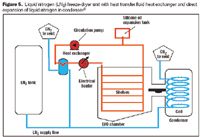
Figure 5.
To avoid two-phase flow and the related nonuniform performance of the condenser, a so-called fluid condenser option is also available. In this case, one or more dedicated compressors or cryogenic heat exchangers may cool a separate HTF loop, which in turn cools the fluid condenser. The downside of a fluid condenser is the potential for frictional heat generation. If a cryogenic heat exchanger is applied, a low HTF velocity helps minimize the parasitic heat generation. The efficiency benefits gained from more uniform use of the condenser surface often outweigh the minor increase in frictional heat generation. A simplified process flow diagram of the refrigeration system for a freeze-drying application developed by Praxair is shown in Figure 6. In place of separate dedicated refrigeration systems for the shelves and condenser, we recommend a unique configuration with a single nonfreezing cryogenic heat exchanger. This heat exchanger cools two HTF loops with differing temperature setpoints and refrigeration demands. The warmer HTF loop cools the shelves, the colder one the condenser. Major advantages of the single-heat-exchanger configuration include significantly reduced capital cost for the refrigeration system and lower LN2 consumption compared to cryogenic refrigeration systems that use both a heat exchange system and a LN2 DX condenser to meet the cooling requirements of the lyophilization process.
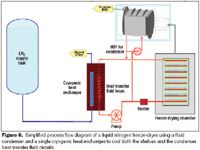
Figure 6.
COST OF OWNERSHIP ANALYSIS FOR LIQUID NITROGEN AND MECHANICAL REFRIGERATION IN FREEZE-DRYING
Table 1 illustrates the key components of the cost of ownership of the refrigeration part of a freeze-dryer. Both the capital items and operating costs were considered. Overall, if one considers the cost of auxiliary systems and maintenance for mechanical refrigeration, LN2 units are less expensive. After many years of operation of commercial mechanical units, the same conclusion was drawn by Liu.6
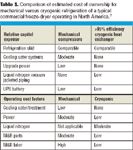
Table 1. Comparison of estimated cost of ownership for mechanical versus cryogenic refrigeration of a typical commercial freeze-dryer operating in North America.7
The amount of nitrogen required for refrigeration will depend largely on the thermal efficiency of the cryogenic heat exchange system. High efficiency, nonfreezing systems that operate at low pressure use 15–30% less nitrogen than high-pressure nonfreezing systems and systems that do not use a nonfreezing design. LN2 costs can account for as much as 50% of the overall costs to operate a cryogenic freeze-drying system. Therefore, LN2 refrigeration efficiency should be considered while selecting the cryogenic refrigeration system.
OTHER KEY CONSIDERATIONS
Reliability
The inherent reliability of cryogenic refrigeration systems is important to manufacturers of high-value and sensitive products, such as protein therapeutics and vaccines. Lyophilization production managers often worry about the breakdown of the mechanical compressors on their freeze-dryers, which would lead to the loss of entire batches. A cryogenic refrigeration skid contains no moving parts unlike compressor-based mechanical refrigeration skids. Properly used and maintained, LN2/GN2-based refrigeration systems can run for decades with minimal maintenance requirements and a low chance of failure. The resulting savings in maintenance and repair of both parts and labor can amount to hundreds of thousands of dollars over the life of a commercial freeze-dryer. In addition, the value of the significant reduction in the risk of mechanical failure and subsequent loss of a batch due to catastrophic compressor or power failure can often be measured in excess of a million dollars, depending on the product.
Flexibility
Calculating the exact cycle specifications for product cool-down rate, freezing, and temperature profiles to be delivered by the refrigeration and heating system depend heavily on the particular characteristics of the product. These profiles may differ radically depending on the product formulation. The more flexible the design of the refrigeration system, the more versatile the unit will be. Additional flexibility and control will better position the owner for processing new formulations with new requirements. Cryogenic refrigeration using LN2/GN2 enables manufacturers to operate across a broad range of processing parameters, both at cool-down and at constant cooling to temperatures lower than –80 °C. Using a cryogenic system, the lowest temperature on the shelves is limited by the thermo-physical properties of the HTF, not the refrigerant. Direct expansion of cryogens in the condenser or a nonfreezing cryogenic heat exchanger with a high performance HTF can provide temperatures below –100 °C in the condenser.
Footprint
A cryogenic refrigeration system requires fewer and less complex components. Typically, a cryogenic refrigeration skid only requires approximately one-half to one-third the space of a comparable mechanical compressor-based skid.
Environmental Impact
Nitrogen is an inert molecule that is nontoxic and nonflammable, with no ozone-depleting or global warming potential. It comes from, and returns to the atmosphere after giving off its refrigeration. Most HFC-based refrigerants are either toxic, flammable, or both. LN2/GN2 refrigeration of the lyophilization operation reduces space requirements and noise, and is environmentally friendly.
CONCLUSION
The growth of LN2/GN2 freeze drying is particularly driven by the need for 1) increased reliability for high-value products, 2) enhanced flexibility, 3) increasing number of formulations containing biologics and 4) dosages with high-fill depth and high volume. The users of lyophilization technology and related equipment are just starting to realize many of its benefits. Many decision makers, still unaware of the benefits associated with LN2/GN2 systems, are also surprised at the lower cost of ownership of a well-designed LN2/GN2 system offering high LN2 efficiency at a low capital expenditure. These features are also worth considering for manufacturers aiming to increase the efficiency, operating flexibility, and profitability of lyophilization systems while controlling costs.
Balazs Hunek, PhD, is a senior manager of technology, 630.320.4242, balazs_hunek@praxair.comAlan Cheng, PhD, is a senior development associate, R&D, and John Capettini is a manager of global applications market development, all at Praxair, Inc.
REFERENCES
1. Perry RH, Green DW. Perry's chemical engineers' handbook 7th ed. McGraw-Hill;1997.
2. Lines J. How low can you go? Chem Process 2003 Jan;35.
3. Cheng ATY, Devack DL. (Praxair) Nonfreezing heat exchanger. US Patent 5,937,656. 1999;Aug 17.
4. Stewart P. Liquid nitrogen: why is progress slow? economic and environmental factors. Pharm Technol Europe 1997;3:44.
5. Telstar. GN2-Tech. Product brief;2005.
6. Liu J, Rouse D. Using liquid nitrogen to maximize lyophilization manufacturing capacity. BioProcess Int. 2005 Feb.
7. Based on Praxair analysis of actual customer experience.
8. Usifroid. Liquid nitrogen applied to freeze drying: performance, reliability, flexibility. 2006. Available from: http://www.usifroid.com/lks/fichiers/1/tele/11-2-15/LN2%204%20pages%20Anglais.pdf.
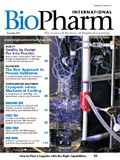
Thermo Fisher Opens Advanced Therapies Collaboration Center in California
April 18th 2025The 6000-square-foot facility will provide cell therapy developers the support they need to transition to CGMP manufacturing, and an expanded footprint of the new center is expected to open in Philadelphia later in 2025.